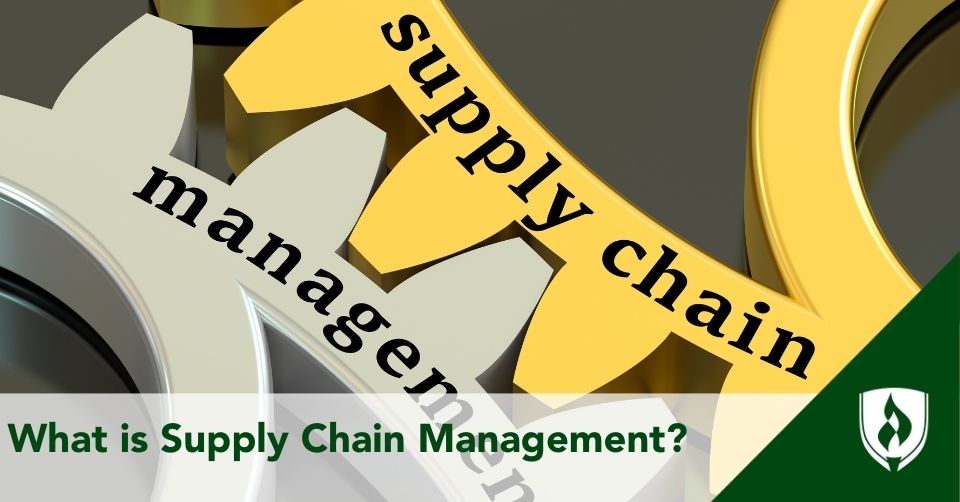What Is Supply Chain Management?
10/07/2025

If you’ve ever wondered about supply chain management (SCM), you’re already thinking like a student. Supply chain management refers1 to the processes that allow goods and services to move from concept to customer. It enables a smartphone designed in one country, assembled in another, and sold worldwide to arrive on store shelves.
At its foundation, supply chain management is about1 designing, planning, executing, and monitoring the supply chain activities that create value. These activities include sourcing raw materials, coordinating manufacturing processes, shipping products through distribution centers, and ultimately delivering them to consumers. In academic programs in supply chain management,2 students examine how these interconnected activities create a competitive infrastructure for organizations, one that matches supply chain solutions to real-world market demand.
Learning about supply chain management introduces you to both the big picture and the details of global commerce. Students study2 how supply chain management professionals balance worldwide logistics, anticipate customer demand, and adapt to supply chain disruptions. They also see how supply chain management plays a role in sustainability, efficiency, and the future of technology in global trade.
Core Functions of Supply Chain Management
Forecasting
Forecasting in supply chain management helps3 businesses anticipate future demand to maintain the right inventory levels, plan production, and coordinate with suppliers. By analyzing historical data and current trends, organizations can ensure products are available when needed without overstocking, reducing waste and improving operational efficiency. Accurate forecasting also supports production scheduling and supplier communication, helping the supply chain run smoothly.
Building a forecast involves3 collecting relevant data, analyzing patterns and trends, selecting an appropriate model, and continuously refining predictions based on actual outcomes. Common methods include time series forecasting, causal forecasting, machine-learning-based forecasting, and qualitative approaches when historical data is limited. Demand and sales forecasting specifically focus on predicting customer needs and sales volumes, providing essential insights to guide supply chain decisions.
Demand and Supply Planning
Demand and supply planning requires4 a careful balance between customer demand and the organization’s ability to meet it. Supply chain professionals use demand planning to forecast sales, enabling them to adjust production levels without overproducing or falling short of customer needs. This process relies on analyzing trends, holidays, geographical factors, and customer interest, helping organizations maintain consistent production while aligning with market demand. A data-driven demand plan forms the foundation for creating a corresponding supply plan, ensuring that enough products are manufactured and supplied efficiently to meet anticipated demand.
Supply planning works in tandem4 with demand planning by detailing how products will be produced, sourced, and distributed to fulfill customer needs. Software tools track sales metrics, inventory levels, and geographic considerations across multiple fulfillment locations, allowing adjustments in real time to reflect changes in demand. Innovations such as artificial intelligence, machine learning, and blockchain are further enhancing supply planning by automating processes, improving traceability, and increasing delivery speed. Effective supply planning also considers supplier reliability, employee performance, and sustainable practices, emphasizing a collaborative team approach where roles are clear and decisions are informed by continuous data analysis.
Sourcing
Sourcing in supply chain management involves5 the strategic selection of suppliers for raw materials, components, or finished products. It includes evaluating suppliers, analyzing market capabilities, and making make-or-buy decisions to ensure cost efficiency, quality, and timely delivery. A well-managed sourcing process helps organizations understand the market, foster competition among suppliers, and make informed procurement decisions.
Global sourcing extends5 this process internationally, leveraging lower labor costs, cheaper materials, and favorable economic conditions. Effective global sourcing requires a strategic approach to balance benefits and risks, determining whether to produce in-house or source locally, regionally, or globally. This helps organizations optimize their supply base and maintain competitiveness in a global market.
Operations Management
Operations management in supply chain management supports6 the movement and storage of goods through the supply chain network. It involves demand management, inventory management, logistics management, and the fulfillment process from sourcing raw materials to final delivery.
Supply chain managers often rely on digital tools, artificial intelligence and machine learning. In a 2024 study7 on generative artificial intelligence in supply chain and operations management, researchers highlighted how advanced digital tools, particularly Generative AI (GAI), are reshaping supply chain and operations management. By integrating capabilities such as learning, perception, prediction, interaction, adaptation, and reasoning, these tools enhance decision-making, optimize processes, and increase resilience across supply chain networks.
The research proposes7 a capability-based framework that guides organizations in systematically applying GAI to areas like demand forecasting, inventory management, supply chain design, and risk management. As a result, digital tools powered by GAI help supply chain professionals navigate complexities, improve efficiency, and respond more effectively to uncertainty in global supply chains.
Inventory Management
Inventory management in supply chain management is the process8 of tracking and controlling stock as it moves in and out of warehouses to ensure the right balance between supply and demand. A strong inventory management system updates in real time as products are sold or used, helping organizations avoid both shortages and surpluses. This balance is critical not only for meeting customer needs but also for maintaining smooth cash flow, efficient logistics, and regulatory compliance.
There are many types8 of inventory, ranging from raw materials and work-in-progress items to finished goods, backup stock, packaging, and even service capacity. Managing these effectively allows organizations to reduce waste, minimize excess stock, and prepare for fluctuating demand. The benefits are clear: Cost savings through better storage and logistics, improved customer satisfaction by avoiding backorders, and greater flexibility in cash flow as inventory moves consistently through the system.
Despite these advantages, inventory management comes with challenges8 such as maintaining accuracy, forecasting shifting demand, and ensuring organized storage. To address these issues, businesses rely on tools, automation, and skilled professionals trained in best practices. When paired with supply and demand planning, effective inventory management strengthens the entire supply chain by aligning forecasting, replenishment, and fulfillment strategies.
Warehousing
Warehousing in supply chain management serves9 as more than just a storage solution. It acts as a central hub between production, procurement, and distribution, ensuring the smooth flow of goods while providing value-added services. Warehousing encompasses activities such as receiving, storing, and shipping materials, as well as tracking inventory, processing orders, and packaging products for shipment. The use of strategically located warehouses helps businesses maintain optimal stock levels, manage climate-sensitive products, and ensure timely delivery to customers, enhancing overall supply chain efficiency.
Different types9 of warehouses cater to varying business needs, from private warehouses owned by large companies to public, cooperative, bonded, automated, and cold storage facilities. Modern warehouses often incorporate advanced technologies for automated logistics, real-time tracking, and demand forecasting, enabling better decision-making and operational efficiency. Beyond storage, warehouses serve as consolidation points, facilitate break-bulking of shipments, and provide value-added services such as labeling, customization, and returns processing. Effective warehousing supports cost savings, scalability, improved customer service, and enhanced visibility, making it an essential element in achieving a responsive and reliable supply chain.
Logistics
Logistics in supply chain management oversees10 the planning, coordination, and movement of goods, materials, and resources. It ensures products reach the right place at the right time while optimizing inventory, warehousing, transportation, and order fulfillment. Effective logistics management improves efficiency, reduces costs, mitigates risks, and enhances customer satisfaction through timely and accurate deliveries.
It includes10 supply management, distribution logistics, production logistics, and customer service logistics, all working together to streamline the flow of goods. By using tools like automation, tracking systems, and smart route planning, logistics management boosts operational efficiency, lowers costs, and strengthens overall supply chain performance.
Distribution
Distribution involves1 transporting materials like finished products or service components from the manufacturer to the end customer. It encompasses11 activities such as transportation, warehousing, inventory management, and order fulfillment, all of which are essential to maintaining a smooth flow of goods. Effective distribution ensures that the right products reach the right place at the right time, which not only satisfies customer demand but also minimizes storage and transportation costs. By integrating these functions, organizations can maintain consistent service levels, reduce lead times, and improve overall supply chain performance.
Lean supply chain principles enhance11 distribution by eliminating waste, streamlining processes, and optimizing resources. Applying these strategies reduces excess inventory, improves delivery accuracy, and boosts responsiveness to demand changes, making distribution a strategic component that drives efficiency, customer satisfaction, and profitability.
Risk Management
Supply Chain Risk Management (SCRM) is the structured process12 of identifying, assessing, and mitigating potential disruptions in a supply chain. Its purpose is to reduce negative impacts on supply chain performance by anticipating problems before they affect operations. Supply chain professionals focus on threats that can occur at any stage, from sourcing raw materials to delivering finished products, helping maintain smooth flow, reliability, and customer satisfaction.
SCRM involves three12 key steps: Identification, mitigation, and monitoring.
- Identification maps potential threats, whether internal, like production delays, or external, such as natural disasters or geopolitical events.
- Mitigation implements strategies to contain risks.
- Monitoring ensures these risks don’t recur.
Supply chain managers are typically responsible for addressing risks across four12 pillars: Supply, demand, process, and environmental/ecosystem risks, using tools like supply chain mapping, risk software, and cybersecurity measures.
Despite best efforts, SCRM comes with challenges,12 including limited visibility into supplier networks, complex multi-tiered supply chains, unpredictable demand shifts, and regulatory requirements. By promoting transparency, rapid response, and proactive monitoring, supply chain professionals can manage both known and unknown risks while enhancing supply chain resilience, supporting reliable operations, and sustaining a global supply chain network.
Exploring the Supply Chain Management Process
Supply chain management may help reduce costs, minimize waste, and shorten production timelines,1 and may also ensure products reach the right place at the right time, directly enhancing customer satisfaction and loyalty. Many industries rely on supply chain management daily,1 using it to ensure that products and materials are available where and when they are needed, maintain efficient operations, and respond effectively to changing demand.
Students in higher education may examine case studies2 that highlight how businesses manage procurement, supplier payments, quality control, and process standardization. It also shows how supply chain management supports sustainable practices and strengthens competitive infrastructure. Overall, supply chain management connects multiple functions that keep economies moving,1 making it essential for understanding how businesses operate and meet global demand efficiently.
Discover what you can do with a supply chain management degree and explore the career paths this dynamic field offers.
1ASCM, Supply Chain Management, available at https://www.ascm.org/topics/supply-chain-management/ (accessed Aug. 19, 2025).
2Rasmussen University, Supply Chain and Logistics Management Degree Program, available at https://www.rasmussen.edu/degrees/business/supply-chain-and-logistics-management/ (accessed Aug. 19, 2025).
3ASCM Houston, The Importance of Forecasting in Supply Chain Management, available at https://houston.ascm.org/blog/The-Importance-of-Forecasting-in-Supply-Chain-Management (accessed Aug. 19, 2025).
4ASCM, Supply Planning, available at https://www.ascm.org/topics/supply-planning/ (accessed Aug. 19, 2025).
5Rout, Manoj Kumar, Sourcing Management (2021), available at http://biitm.dspaces.org/bitstream/123456789/350/1/SOURCING%20MANAGEMENT.pdf (accessed Aug. 19, 2025).
6ASCM Houston, What is Operations and Supply Chain Management, available at https://houston.ascm.org/blog/what-is-operations-and-supply-chain-management (accessed Aug. 19, 2025).
7Jackson, I., Ivanov, D., Dolgui, A., & Namdar, J., Generative artificial intelligence in supply chain and operations management: a capability-based framework for analysis and implementation, International Journal of Production Research, 62(17), 6120–6145, 2024, https://doi.org/10.1080/00207543.2024.2309309 (accessed Aug. 19, 2025).
8ASCM, Inventory Management, available at https://www.ascm.org/topics/inventory-management/ (accessed Aug. 19, 2025).
9ASCM, Warehousing, available at https://www.ascm.org/topics/warehousing/ (accessed Aug. 19, 2025).
10ASCM, Logistics Management, available at https://www.ascm.org/topics/logistics-management/ (accessed Aug. 19, 2025).
11Myerson, Paul. AccessEngineering Library, Book Summary, available at https://www.accessengineeringlibrary.com/binary/mheaeworks/a6f7eb8a50e3a038/740099a19141e618a67d3da8cce06d3edcbbdb1f24003ce404ab28e3033a6c6b/book-summary.pdf (accessed Aug. 19, 2025).
12ASCM, Supply Chain Risk Management, available at https://www.ascm.org/topics/supply-chain-risk-management/ (accessed Aug. 19, 2025).



